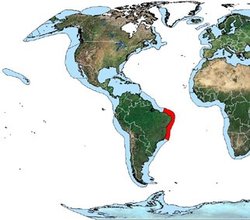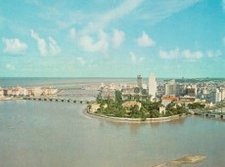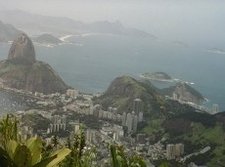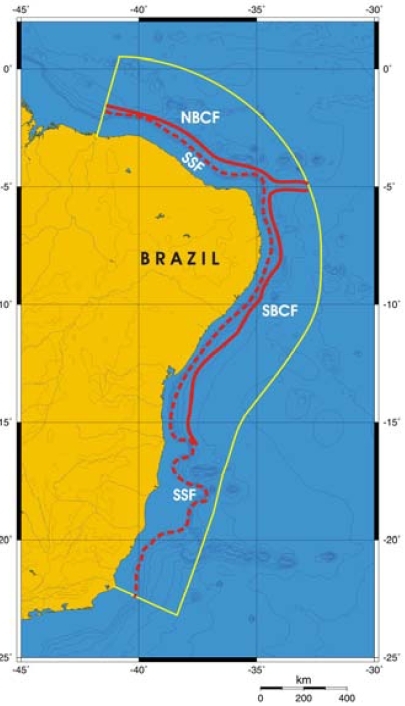East Brazil Shelf large marine ecosystem
The East Brazil Shelf Large Marine Ecosystem (LME) is characterized by its mixed climate. It is situated on the Southwest Atlantic between 3 and 22 degrees of latitude South. It encompasses the coastal region from the Parnaiba Estuary to Cape Sao Tome. For a map of this LME, see Ekau and Knoppers, 2003. Apart from the Abrolhos Bank, this LME has a narrow shelf. It is a typical oligotrophic system dominated by the South Equatorial Current, which has an offshoot along Brazil’s North Coast (the North Brazil Current) and to the South (the Brazil Current). It has a diverse food web and low production. LME book chapters and articles pertaining to the South Brazil Shelf include Bakun, 1993, and Ekau and Knoppers, 2003.
Contents
- 1 Productivity
- 2 Fish and Fisheries
- 3 Pollution and Ecosystem Health
- 4 Socioeconomics
- 5 Governance
- 6 References
- 6.1 Articles and LME Volumes Bakun, A., 1993: The California Current, Benguela Current, and Southwestern Atlantic shelf ecosystems: A comparative approach to identifying factors regulating biomass yields. In: Sherman, K.; Alexander, L.M.; Gold, B.D. (eds.), 1993: Large marine ecosystems: stress, mitigation and sustainability of large marine ecosystems. AAAS Publication, 92-39S: 199-224. ISBN: 087168506X (East Brazil Shelf large marine ecosystem) . * Ekau, W. and B. Knoppers, 2003. A review and redefinition of the large marine ecosystems of Brazil. In: K. Sherman and G. Hempel (eds.). Large Marine Ecosystems of the World --Trends in Exploitation, Protection and Research . Elsevier Science. Amsterdam.ISBN: 0444510273. * Prescott, J.R.V. 1989. The political division of large marine ecosystems in the Atlantic Ocean and some associated seas. In K. Sherman and L.M. Alexander, eds. Biomass Yields and Geography of Large Marine Ecosystems. AAAS Selected Symposium 111. Westview Press, Boulder CO. 395-442. ISBN: 0813378443.
- 6.2 Other References
- 6.3 Citation
Productivity
 Location of the East Brazil Shelf Large Marine Ecosystem. (Source: NOAA)
Location of the East Brazil Shelf Large Marine Ecosystem. (Source: NOAA) For a description of the system of currents and of the water masses, see Emilsson (1959), and Castro and Miranda (1998). The LME has mesotides. The Abrolhos Bank and archipelago form a topographical barrier along the pathway of the Brazil Current. This area is the largest and richest area of coral reefs in the South Atlantic, with 16 species of stony coral recorded. Chapeiroes are mushroom-shaped pinnacles highly characteristic of Brazilian reefs. About 35 rivers, the largest of which are the Jequetinhonha, Mucuri, Doce and Paraiba do Sul rivers, provide an input of freshwater to the [[coastal] areas]. The East Brazil LME is considered a Class III, low productivity (<150 gC/m2/yr) ecosystem based on SeaWiFS global primary productivity estimates. Studies on primary productivity for this LME are scant. The Victoria Eddy along the eastern shelf edge (see Schmid et al., 1995) creates an upwelling of nutrient-rich South Atlantic Central Water (see Gaeta et al., 1999), leading to higher primary production rates. For plankton characteristics, see Ekau and Knoppers, 2003. This LME is a transition zone in terms of the distribution patterns of the different taxonomic groups and the microplankton. It is influenced both by northern tropical warm waters and by southern colder upwellings (see Ekau, 1999). For results of an oceanographic cruise conducted off the East coast of Brazil, see Joint Oceanographic Projects.
Fish and Fisheries
 (Source: NOAA)
(Source: NOAA) Herring, snapper, mackerel, and albacore are some of the commercial species harvested. Fish catches tend to be low. Fisheries are dominated by artisanal fishing methods. Industrial fisheries are significant only in the states of Ceara (lobster and southern red snapper), and Espirito Santo State (shrimp). Snapper, triggerfish, swimcrabs and Atlantic seabobs are dominant in the landings of Abrolhos Bank. Tunas are caught offshore around seamounts and banks. Information on the exploitation of fish stocks is not available for all areas and species. For more information on nearshore, demersal and coastal species, see Ekau and Knoppers, 2003. See Food and Agriculture Organization (FAO) statistics for fisheries yields in FAO, 2000. The Global International Waters Assessment (GIWA) has issued a matrix that ranks LMEs according to the sustainable exploitation of fisheries and the predicted direction of future changes. GIWA characterizes the LME as severely impacted in terms of overfishing, excessive bycatch and destructive fishing practices. These impacts are increasing (see the GIWA web site). For detailed fish catch statistics for this LME, see data collected by the University of British Columbia Fisheries Center. REVIZEE is a Brazilian program presently assessing the sustainable living resources of the EEZ. CEPENE is a regional department of the Brazilian Institute of Environment and Natural Renewable Resources (IBAMA), responsible for the north-eastern and eastern coast from Rio Paranaiba to north of Abrolhos. One project aiming to reduce the bycatch in shrimp trawls is being conducted with small vessels in Pernambuco State in cooperation with the Fishing Extension Center of the Northeast (CEPENE/IBAMA) and the commercial fleet. See more information on fisheries at the website of the Brazilian Institute of Environment and Natural Renewable Resources.
Pollution and Ecosystem Health
Areas of global concern are climate change, biodiversity; and ozone depletion. The Global International Waters Assessment (GIWA) has issued a matrix that ranks LMEs according to pollution, and the predicted direction of future changes. GIWA characterizes the LME as severely impacted in terms of eutrophication, microbiological pollution, chemical pollution and solid wastes, with severe economic consequences. These impacts are increasing. In terms of habitats, the LME is severely impacted in terms of loss or modification of ecotones. This impact is also increasing (see the GIWA web site). The main sources of marine pollution in the LME are linked to land-based activities, especially those arising out of unplanned coastal development, tourism and recreation centers, and ocean transport. The growth of illegal fishing, industrial fishing and of ocean pollution are of concern because of their effect on several marine species and on turtles. The LME has 5 species of turtles, all protected by law. This agricultural area uses fertilizers and pesticides. There is evidence of pressure on the LME’s coral reefs, and coral bleaching has been reported in northern Bahia and in Abrolhos reefs. However, the levels of mortality still remain low. The coast is very vulnerable to tanker movement, and oil spills occurred in 1974 (“Esso Garden State”), 1975 (“Yarik Ibn Ziyad”), 1978 (“Brazilian Marina”), 1985 (“Marina”) and 1986 (“Brotas”). In each case the spill involved more than 10,000 barrels of oil.
Socioeconomics
 Brazil. (Source: NOAA)
Brazil. (Source: NOAA) Fishing is practiced on a small scale and is mostly artisanal (see Ekau and Knoppers, 2003).
Tourism and ecotourism are increasing in importance in the State of Bahia. Salvador-Bahia is Brazil’s third largest city. A former slave market for Brazil, it has since developed petrochemical industries and oil refineries. There is a commerce in salt, and mangroves have been damaged by the introduction of salt pans. There is evidence of a correlation between economic growth, poverty, and environmental degradation. Ecological problems are deeply rooted in social, political, as well as economic factors. There are major societal and technological challenges in trying to address poverty and reduce the income gap between rich and poor.
Governance
The East Brazil Shelf LME is bordered by the Brazilian states of Piaui, Ceara, Rio Grande do Norte, Paraiba, Pernambuco, Alagoas, Sergipe, Bahia, and Espirito Santo. There is a need for regulations dealing with the conservation and preservation of affected coastal [[ecosystem]s] and habitats. Brazil has expended great efforts to assess the state of the living and non-living resources within its Exclusive Economic Zone. A management effort is underway for the Sao Francisco watershed, which has relevance for the whole marine ecosystem. Some of the requirements for sustainable development include the alleviation of poverty, innovative development strategies, technological improvements and sound conservation policies. The greatest constraints are the lack of harmonized legal instruments and financial mechanisms, as well as discrepancies in the capabilities of national and regional experts and managers. Brazil has an ongoing [[coastal] zone] management program. Information on the exploitation of Brazilian fish stocks is not available for all areas and species (see Ekau and Knoppers, 2003). CEPENE is a regional department of the Brazilian Institute of Environment and Natural Renewable Resources (IBAMA), responsible for the north-eastern and eastern coast from Rio Paranaiba to north of Abrolhos.
References
Articles and LME Volumes Bakun, A., 1993: The California Current, Benguela Current, and Southwestern Atlantic shelf ecosystems: A comparative approach to identifying factors regulating biomass yields. In: Sherman, K.; Alexander, L.M.; Gold, B.D. (eds.), 1993: Large marine ecosystems: stress, mitigation and sustainability of large marine ecosystems. AAAS Publication, 92-39S: 199-224. ISBN: 087168506X (East Brazil Shelf large marine ecosystem) . * Ekau, W. and B. Knoppers, 2003. A review and redefinition of the large marine ecosystems of Brazil. In: K. Sherman and G. Hempel (eds.). Large Marine Ecosystems of the World --Trends in Exploitation, Protection and Research . Elsevier Science. Amsterdam.ISBN: 0444510273. * Prescott, J.R.V. 1989. The political division of large marine ecosystems in the Atlantic Ocean and some associated seas. In K. Sherman and L.M. Alexander, eds. Biomass Yields and Geography of Large Marine Ecosystems. AAAS Selected Symposium 111. Westview Press, Boulder CO. 395-442. ISBN: 0813378443.
Other References
- Bakun, A.; Parrish, R.H., 1991: Comparative studies of coastal pelagic fish reproductive habitats: the anchovy (Engraulis anchoita) of the southwestern Atlantic. ICES J. mar. Sci., 48: 343-361.
- Brandini, F.P., 1990: Produção primária e características fotosintéticas do fitoplâncton na região sueste do Brasil. Bolm. Inst. oceanogr., S.Paulo, 38(2): 147-159.
- Castro, B.M.; Miranda, L.B., 1998: Physical oceanography of the western Atlantic continental shelf located between 4°N and 34°S. In: Robinson, A.R.; Brink, K.H. (eds.): The Sea, Vol. 11: 209-252, New York, John Wiley & Sons. ISBN: 0674017412.
- Dias-Neto, J.; Mesquita, J.X., 1988: Potencialidade e explotação dos recursos pesqueiros do Brasil. Ciência e Cultura, São Paulo, 40(5): 427-441.
- Dominguez, J.M.L.; Bittencourt, A.C., 1996: Regional Assessment of Long-term trends of coastal erosion in northeastern Brazil. An. Acad. bras. Ci., 68(3): 355-371.
- Ekau, W.1999: Topographical and hydrographical impacts on macrozooplankton community structure in the Abrolhos Bank region, East Brazil. Arch.Fish.Mar.Res. 47(2/3), 307-320.
- Ekau, W.; Knoppers, B., 1999: An introduction to the pelagic system of the North-East and East Brazilian shelf. Arch.Fish.Mar.Res. 47(2/3), 113-132.
- Ekau, W.; Matsuura, Y., Torbohm-Albrecht, s., 1996: Diversity and distribution of macrozooplankton in the eastern continental shelf waters off East Brazil. in: Ekau, W.; Knoppers, B.A., 1996 (eds.): Sedimentation processes and productivity in the continental shelf waters off east and Northeast Brazil. Cruise Report and first results of the Brazilian German project JOPS-II (Joint Oceanographic Projects). Center for Tropical Marine Ecology, Bremen: 139-147.
- Ekau, W.; Westhaus-Ekau, P.; Medeiros, C., 1999: Large Scale Distribution of Fish Larvae in the Continental Shelf Waters off NE-Brazil. Arch.Fish.Mar.Res. 47(2/3), 183-200.
- Emílsson, I. 1959: Alguns aspectos físicos e químicos das águas marinhas brasileiras. Ciência e Cultura, S.Paulo, 11(2):44-54.
- FAO, 2000:Fishery statistics. FAO yearbook vol 86/1 1998, FAO, Rome.
- Freire, A.S., 1991: Variação espaço-temporal do zooplâncton e das espécies de Euphausiacea (Crustacea) ao largo da Costa Leste do Brasil (23 - 18 °S, 41 - 38°W). Dissertação de Mestrado, Instituto Oceanográfico, Universidade de São Paulo: 75 pp.
- Gaeta, S.A.; Lorenzetti, J.A.; Miranda, L.B.; Susini-Ribeiro, S.M.M.; Pompeu, M.; De Araujo, C.E.S., 1999: The Victoria Eddy and its relation to the phytoplankton biomass and primary productivity during the austral fall of 1995. Arch.Fish.Mar.Res. 47(2/3), 253-270.
- GERCO-PNMA, 1996: Macrodiagnóstico da zona costeira do Brasil na escala da união. - Gerenciamento Costeiro, Programa Nacional do Meio Ambiente, MMA (Ministério do Meio Ambiente,UFRJ, SUJD, LAGEJ, Brasilia: 280 pp.
- Kjerfre, B.; Lacerda, L.D., 1990: Mangroves of Brazil. In: Lacerda, L.D. (ed.): Conservation and sustainable utilization of mangrove forests in Latin America and Africa regions. Part I - Latin America. ITTO/ISMA Project PD 114/90: 245-271.
- Knoppers, B.; Ekau, W.; Figueiredo, A.G., 1999a: The coast and shelf of east and northeast Brazil and material transport. Geo-Marine Letters 19: 171-178.
- Knoppers, B.; Meyerhöfer, M.; Marone, E.; Dutz, J.; Lopes, R.; Leipe, T.; Camargo, R., 1999b: Compartments of the pelagic system and material exchange at the Abrolhos Bank coral reefs, Brazil. Arch.Fish.Mar.Res. 47(2/3), 285-306.
- Leão, Z.M.A.N. 1996: The coral reefs of Bahia: Morphology, destruction and the major environmental impacts. An. Acad. bras. Ci. 68(3): 439-452.
- Martins, L.R.; Coutinho, P.N., 1981: The Brazilian continental margin. Earth Science Review, 17: 87-107.
- Medeiros, C., Macedo, S., Feitosa, F.A.N., and Koening, M.L., 1999. Hydrology and phytoplankton biomass of the northeastern Brazilian waters. Arch.Fish.Mar.Res. 47(2/3), 133-151.
- Neumann-Leitão, S.; Gusmão, L.M.deO.; Silva, T.A.; Nascimento-Vieira, D.A. do; Silva, A.P., 1999: Mesoplankton biomass and diversity of coastal and oceanic waters off Northeastern Brazil. Arch.Fish.Mar.Res. 47(2/3), 153-165.
- NOAA. 1991. Report of the ad hoc Committee on Large Marine Ecosystems. NOAA Technical Memorandum NMFS-F/NEC-92, 19p.
- Schmid, C.; Schäfer, H.; Podestá, G.; Zenk, W., 1995: The Vitória Eddy and its relation to the Brazil Current. J. Phys. Oceanogr., 25(11): 2532-2546.
- Schwamborn, R., Ekau, W., Pinto, A., Silva, T., Saint-Paul, U., 1999a: The contribution of estuarine decapod larvae to marine macrozooplankton communities in Northeast Brazil. Arch.Fish.Mar.Res. 47(2/3), 167-182.
- Schwamborn, R., Voss, M., Ekau, W., Saint-Paul, U., 1999b: Stable isotope composition of particulate organic matter and zooplankton in northeast Brazilian shelf waters. Arch.Fish.Mar.Res. 47(2/3), 201-222.
- Stuhr, A. 1996: Phytoplankton production measurements. In: Ekau, W.; Knoppers, B.A., 1996 (eds.): Sedimentation processes and productivity in the continental shelf waters off east and Northeast Brazil. Cruise Report and first results of the Brazilian German project JOPS-II (Joint Oceanographic Projects). Center for Tropical Marine Ecology, Bremen: 83-85.
- Summerhayes, C.P.; Coutinho, P.N.; França, A.M.C.; Ellis, J.P., 1975: Salvador to Fortaleza, Northeastern Brazil. In: Upper Continental Margin sedimentation off Brazil. Stuttgart: Contribution to Sedimentology 4: 44-77. ISBN: 3510570049.
- Summerhayes, C.P.; De Melo, U.; Barretto, H.T., 1976: The influence of upwelling on suspended matter and shelf sediments off southeastern Brazil. J. Sedimentary Petrology, 46(4): 819-828.
- Susini-Ribeiro, S.M.M., 1999: Biomass distribution of pico-, nano- and microplankton on the continental shelf of Abrolhos, East Brazil. Arch.Fish.Mar.Res. 47(2/3), 271-284.
- Teixeira, C.; Gaeta, S.A., 1991: Contribution of picoplankton to primary production in estuarine, coastal and equatorial waters of Brazil. Hydrobiologia, 209: 117-122.
- Valentin, J.L.; Monteiro-Ribas, W.M., 1993: Zooplankton community structure on the east-southeast Brazilian continental shelf (18-23°S latitude). Cont. Shelf Res. 13(4): 407-424.
- Vieira, A.A.H.; Teixeira, C., 1981: Excreção de matéria orgânica dissolvida por populações fitoplanctônicas da costa leste e sudeste do Brasil. Bolm. Inst. oceanogr., S. Paulo, 30(1): 9-25.
| Disclaimer: This article is taken wholly from, or contains information that was originally published by, the National Oceanic and Atmospheric Administration (NOAA). Topic editors and authors for the Encyclopedia of Earth may have edited its content or added new information. The use of information from the National Oceanic and Atmospheric Administration (NOAA) should not be construed as support for or endorsement by that organization for any new information added by EoE personnel, or for any editing of the original content. |
